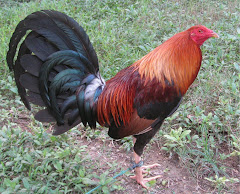Tuesday, November 4, 2008
Cockfighting engrained in cultures
Cockfighting has also been mentioned in songs such as Kings of Leon's Four Kicks and Bob Dylan's song "Cry a while" from the album Love and Theft. The story song El Gallo del Cielo by Tom Russell is entirely about cockfighting, and the lyrics utilize detailed imagery of fighting pits, gamecocks, and gambling on the outcome of the fights.
The Expressionist painter Sir Robin Philipson, of Edinburgh, was well known for his series of works that included depictions of cockfighting.
Wilford Brimley is a high profile supporter of cockfighting.[21] He campaigned unsuccessfully in Arizona and New Mexico against laws banning cockfighting.
The computer game Deus Ex: Invisible War contains a pub that holds "greasel fights", where escaped transgenic creatures ("greasels") are used in place of gamecocks.
Origins
Cockfighting was a pastime in the Indus Valley Civilization by 2000 BC.[3] The Encyclopedia Britannica (2008)—on the origins of cockfighting—holds:[4]
The game fowl is probably the nearest to the Indian red jungle fowl (Gallus gallus), from which all domestic chickens are believed to be descended.
The sport was popular in ancient times in India, China, Persia, and other Eastern countries and was introduced into Greece in the time of Themistocles (c. 524–460 BC). The sport spread throughout Asia Minor and Sicily. For a long time the Romans affected a despisement of this “Greek diversion,” but they ended up adopting it so enthusiastically that the agricultural writer Columella (1st century AD) complained that its devotees often spent their whole patrimony in betting at the side of the pit.
[edit] Regional variations
Spurs taped and tied onto legs
In some regional variations, the birds are equipped with either metal spurs (called gaffs) or knives, tied to the leg in the area where the bird's natural spur has been partially removed. A cockspur is a bracelet (often made of leather) with a curved, sharp spike which is attached to the leg of the bird. The spikes typically range in length from "short spurs" of just over an inch to long spurs almost two and a half inches long. In the highest levels of seventeenth century English cockfighting, the spikes were made of silver. In the naked heel variation, the bird's natural spurs are left intact and sharpened: fighting is done without gaffs or taping, particularly in India (especially in Tamil Nadu) There it is mostly fought naked heel and either three rounds of twenty minutes with a gap of again twenty minutes or four rounds of fifteen minutes each and a gap of fifteen minutes between them.[5]
Nicaragua, Venezuela, Colombia, France, Mexico, Dominican Republic, Italy, Philippines, Peru, Puerto Rico, Canary Islands and Guam have arenas with seats or bleachers for spectators surrounding the ring. In many countries, the spectacle of cockfighting is as popular as baseball and American football are in the United States. Among the competitors who raise fighting cocks, there is great pride in the prowess of their birds and in winning a championship.
[edit] Latin America
[edit] Mexico
Cockfight in Querétaro, Mexico
In Aguascalientes, a state capital, one of the city's principal concert halls is the cockfighting arena, the palenque. During the San Marcos Fair, well-known throughout Mexico, cockfights alternate with important concerts, where the singers or dancers perform from the cockpit. Many popular singers have performed there, e.g. Latin Grammy winners Alejandro Fernandez and Alejandra Guzman [6].
[edit] Asia
[edit] Southeast Asia
Cockfighting is common throughout all of Southeast Asia, where it is implicated in spreading bird flu.[7] Some local terms for cockfights:
* Thailand, Thai: ตีไก่ Tee ky;
* The Philippines, Sabong.
[edit] India
A cockfight in India, 2008
Cockfighting (Vetrukkaal seval porr in Tamil which means "naked heel cock fight") (Kodi Pandem in Telugu) (Kori katta in Tulu) is favourite sport of people living in the coastal region of Andhra Pradesh, Dakshina Kannada and Udupi districts of Karnataka, India. Three or four inch blades (Bal in Tulu) are attached to the cocks' legs. Knockout fights to the death are widely practised in Andhra Pradesh. In Tamil Nadu, the winner is decided after three or four rounds. People watch with intense interest surrounding the cocks. The sport has gradually become a gambling sport.
[edit] Tamil Nadu
Cockfighting in Tamil Nadu is mentioned in ancient literature like Manu Needhi Sastiram, Kattu Seval Sastiram, and other sangam-age literature, 2,000 years old. It is referred to as the favourite past-time for Maravars or the warriors of Tamil Country. It is acknowledged as one of the 64 "arts" widely spoken by the scholars and mastered by the ancestors/scholars of this part of the world. In earlier days they were fighting with the jungle fowl and its variants later, due to the naval expeditions to Java and Malay by the Pandian Rulers the local poultry of that land might have found its way to Tamil Nadu and a new strain/breed started its development in here which later spread to many places such as India. The newer breeds which are known now are The "Reja" (which is a short Variety),"Sonatol","Calcutta Asil","Madras ASil","Kalkatiya" (Also known as "Kadhar" synonymous to Black Asils), The Reds (Also known locally as "Yakuth"),The Yellow Variants (Also known as The "Peela" Asil), The Grey is known locally as "Java" and its variants reddish grey as "Dummer". Also they have a "henny" variety cock known locally as "Pettai Madhiri" the literal meaning is "it looks like a hen", though this variety is said to have come from "Singala Island", or Sri Lanka.
[edit] Pakistan
A cockfight on the outskirts of Kabul, Afghanistan
Cockfighting is popular in Pakistan.[citation needed] Betting is illegal, but police often turn a blind eye towards it. In Sindh (one of 4 major provinces), people are fond of keeping fighting cock breed, known as "Sindhi aseel" in Pakistan. These cocks are noted being tall, heavy and good at fighting. Cock-fighting is popular in rural areas, despite the fact that animal-fighting is banned under Islamic Law.
[edit] Philippines
Cockfighting in the Philippines is called "Sabong". It is one of the Philippines' national sport. There are illegal and legal cockfights. (Even the Filipino boxer Manny Pacquiao has a cock called "Pac-Man".) Many would gamble on the fight.
Legal cockfights are held on cockpits every week. Illegal cockfights, called tupada, happen any time in open areas. In both kind of cockfights, knives are used. Gloves are used for training purposes only.
Derbies are also held. These are cockfights where owners will field a fixed number of cocks. (e.g. 3-cock derby or 6-cock derby). The one with the most wins, wins the jackpot. The Philippines has hosted several World Slasher Derby.
There are 2 kinds of knives used in Philippine cockfighting. The single blade (use in derbies) and double blades.
All knives are attached on the left leg of the cock. But depending on the agreement between owners, blades can be attached on the right leg, or even on both legs.
Sabong and illegal tupada, are judged by a referee called sentensyador, whose verdict is final and not subject to any appeal.[8]
[edit] Pacific Islands
In Guam the sport of cockfighting has been accepted as a cultural tradition dating back to the Spanish rule. Cockfighting became more popular with an influx of Filipino immigrants to the island before and after World War II. Cockfighting events are held throughout the week at a government licensed pit in the village of Dededo and in other villages during fiestas where a patron saint of that village is celebrated. Imported roosters and hens from the U.S. fetch a heavy price.
[edit] Legal issues
Cockfight in Otavalo, Ecuador
In many places, cockfights and other animal fights have been outlawed, often based on opposition to gambling or animal cruelty. In the United States cockfighting is against the law. It is also illegal to possess, raise, train, advertise, or trade cocks or accoutrements that could be used for cockfighting. Also, participating in a cockfight in any manner is illegal: advertising, transporting participants or spectators, placing wagers, hosting an event, etc. It is common for law enforcement to impound property associated with any cockfighting activity [9].
[edit] Europe
[edit] United Kingdom
Cockfighting was banned outright in England and Wales and in the British Overseas Territories with the Cruelty to Animals Act 1835. Sixty years later, in 1895, cockfighting was also banned in Scotland, where it had been relatively common in the eighteenth century.[10] . The Museum of Welsh Life contains a reconstructed cockpit[11] and a reference exists in 1774 to a cockpit at Stanecastle in Scotland.[12]
According to the RSPCA, cockfighting in England and Wales still takes place, but has declined in recent years.[13]
[edit] France
Holding cockfights is a crime in France, but there is an exemption under subparagraph 3 of article 521-1 of the French penal code for cockfights and bullfights in locales where an uninterrupted tradition exists for them. Thus, cockfighting is allowed in the Nord-Pas de Calais region, in Metropolitan France, where it takes place in a small number of towns including Raimbeaucourt, La Bistade[14] and other villages around Lille.[15] On Réunion Island, there are five officially authorized gallodromes (i.e. cockfighting arenas).
[edit] United States
Cockfighting club in Puerto Rico
Cockfighting has a tradition in some American cultures and history. It is said that some founding fathers participated in cockfighting including Washington and Jefferson.[16] With the influx of immigrants from Central America and Asia, they have each added new forms of cockfighting.
In the United States, cockfighting is illegal in all 50 U.S. states and Washington, D.C.. The last state to implement a state law banning cockfighting was Louisiana; the Louisiana State Legislature voted to approve a Louisiana ban in June 2007. The ban took effect in August 2008. Thirty-three states and the District of Columbia have made cockfighting a felony, and it is illegal in 40 states and the District of Columbia to be a spectator at cockfights. Animal welfare activists continue to lobby for a ban on the sport. Cockfighting remains legal in the United States territories of Puerto Rico, the U.S. Virgin Islands, and Guam, although in 2006, the Virgin Islands adopted a law banning the use of artificial spurs.
The Animal Fighting Prohibition Enforcement Act, a federal law that made it a crime to transfer cockfighting implements across state or national borders and increasing the penalty for violations of federal animal fighting laws to three years in prison became law in 2007. It passed the House of Representatives 368-39 and the Senate by unanimous consent and was signed into law by President George W. Bush.[17]
[edit] Cocke County, Tennessee arrests
On June 11, 2005 a number of law enforcement agents raided a cockfighting pit in Del Rio, Tennessee.[18]. Authorities claim this was one of the largest and oldest cockfighting operations in the United States. The agents arrested 144 people, killed over 300 roosters, and confiscated $40,000 in cash. The 144 people arrested were booked on charges of being spectators at a cockfight, a misdemeanor. In Tennessee, defendants found guilty of those charges face up to eleven months and twenty-nine days in jail, plus fines up to $2,500.[19]
Welcome. To read the articles, please click post link or month, then subsequent post link.
Ponkan broodcock

One of the ponkan broodcocks being readied by RB Sugbo for the incoming breeding season. RB Sugbo is among the gamefowl farms very much involved in the Masang Nagmamanok (MANA) Inc. nationwide gamefowl dispersal program.
Another ponkan

Another ponkan broodcock in the trio pen.
Mana: Dami at Pagkakaisa
Walang duda napakalaki na ng pinagunlad ng sabong mula sa paging libangan tuwing araw ng Linggo, ito ngayon ay isa nang napakatanyag na isport, malaking industriya at kaakitakit na mapagkakitaan.
Napakarami nang nagpapalahi ng manok panabong. Nagsilabasan ang mga babasahin at programa sa telebisyon ukol sa sabong.
Sa bawat nagpapalahi, ilan ang tagapagalaga ng kanyang manok? Sa bawat may-ari ng sabungan, ilan ang naghahanapbuhay sa sabungan niya? Sa bawat kasali sa derby, ilan ang nagbabayad sa pinto upang manood? Sa bawat malaking sabungero, ilan ang mayroon lang iilang pirasong tinale sa kanilang bakuran? Dapat lang, at napapanahon na siguro, na ang masang sabungero ay mapagtuonan ng pansin, mabigyan ng kinatawan, at, marinig ang boses sa isport at industriya ng sabong.
Ito ang nais abutin ng MANA (Masang Nagmamanok), isang pambansang kilusan at samahan ng mga masang sabungero. Ang mga layunin ng MANA ay ang sumusunod:
1. Ang pangalagaan ang kapakanan ng mga maliit na sabungero, partikular na, ang mga naghahanapbuhay sa sabungan. Inaasam na sa darating na panahon, ang mga handlers, mananari, casador, kristos, sentensiyador, farm hands ay magkakaroon ng mga benepisyo tulad ng insurance, pension at iba pa.
2. Ang mapatingkad ang kaalaman ng ordinaryong sabungero sa pagmamanok. At, sila’y mabigyan ng pagkakataon na magkaroon ng angkop na materyales sa pagpapalahi at paglalaban.
3. Ang ipaglaban ang sabong sa gitna ng banta na itoy gawing labag sa batas tulad ng nangyari kamakailan lang sa Estados Unidos, at ipreserba ito bilang isport, hanapbuhay, industriya at bahagi ng ating kultura at tunay na mana.
4. Ang magtulungan at makipagtulungan sa iba pang haligi ng industriya sa ikabubuti ng sabong at ikauunlad ng lahat na mga sabungero.
Inaasahan na matupad ng MANA ang nasabing mga layunin pamamagitan ng pagpakita ng dami at pagkakaisa.
Ang pagkatatag ng MANA ay bunsod ng mungkahi ni kamanang Boying
Ang Llamado Tayo ay tumatalakay sa ibatibang aspeto sa pagmamanok at binabasa ng napakarami arawaraw, kaya di nagtagal marami ang sumapi sa MANA.
Kasunod nito, ang MANA ay nakapagpaseminar sa ibatibang lugar at rehiyon ng Pilipinas, sa tulong ng mga kumpaniya tulad ng Excellence Poultry & Livestock Specialist, Bmeg-Derby Ace, Sagupaan, Secret Weapon, at Thunderbird.






